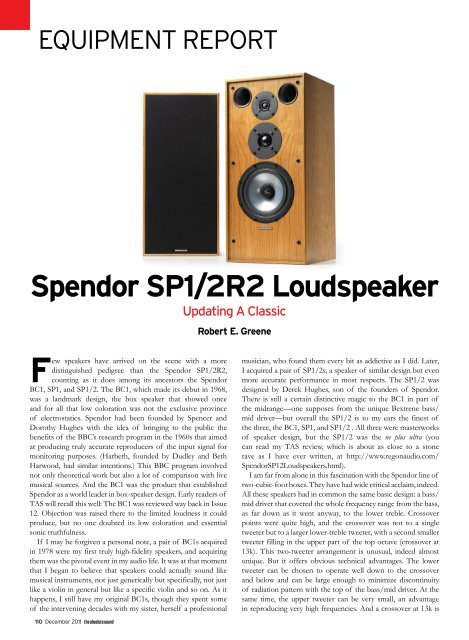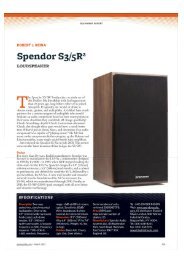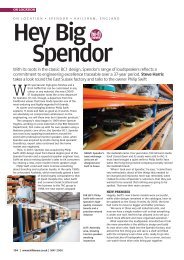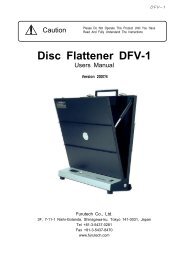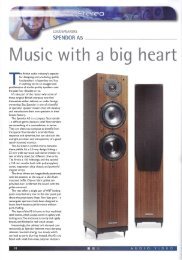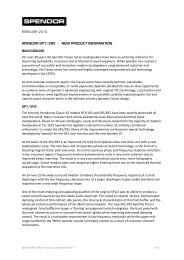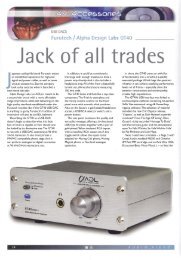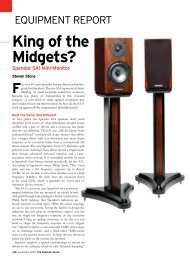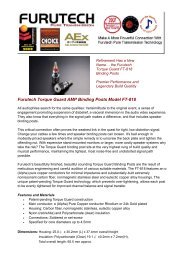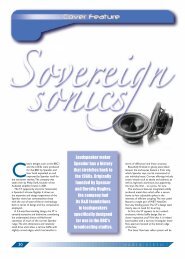Spendor SP1/2R2 Loudspeaker
Spendor SP1/2R2 Loudspeaker
Spendor SP1/2R2 Loudspeaker
Create successful ePaper yourself
Turn your PDF publications into a flip-book with our unique Google optimized e-Paper software.
EQUIPMENT REPORT<br />
<strong>Spendor</strong> <strong>SP1</strong>/<strong>2R2</strong> <strong>Loudspeaker</strong><br />
updating A Classic<br />
Few speakers have arrived on the scene with a more<br />
distinguished pedigree than the <strong>Spendor</strong> <strong>SP1</strong>/<strong>2R2</strong>,<br />
counting as it does among its ancestors the <strong>Spendor</strong><br />
BC1, <strong>SP1</strong>, and <strong>SP1</strong>/2. The BC1, which made its debut in 1968,<br />
was a landmark design, the box speaker that showed once<br />
and for all that low coloration was not the exclusive province<br />
of electrostatics. <strong>Spendor</strong> had been founded by Spencer and<br />
Dorothy Hughes with the idea of bringing to the public the<br />
benefits of the BBC’s research program in the 1960s that aimed<br />
at producing truly accurate reproducers of the input signal for<br />
monitoring purposes. (Harbeth, founded by Dudley and Beth<br />
Harwood, had similar intentions.) This BBC program involved<br />
not only theoretical work but also a lot of comparison with live<br />
musical sources. And the BC1 was the product that established<br />
<strong>Spendor</strong> as a world leader in box-speaker design. Early readers of<br />
TAS will recall this well: The BC1 was reviewed way back in Issue<br />
12. Objection was raised there to the limited loudness it could<br />
produce, but no one doubted its low coloration and essential<br />
sonic truthfulness.<br />
If I may be forgiven a personal note, a pair of BC1s acquired<br />
in 1978 were my first truly high-fidelity speakers, and acquiring<br />
them was the pivotal event in my audio life. It was at that moment<br />
that I began to believe that speakers could actually sound like<br />
musical instruments, not just generically but specifically, not just<br />
like a violin in general but like a specific violin and so on. As it<br />
happens, I still have my original BC1s, though they spent some<br />
of the intervening decades with my sister, herself a professional<br />
110 December 2011 the absolute sound<br />
Robert E. Greene<br />
musician, who found them every bit as addictive as I did. Later,<br />
I acquired a pair of <strong>SP1</strong>/2s, a speaker of similar design but even<br />
more accurate performance in most respects. The <strong>SP1</strong>/2 was<br />
designed by Derek Hughes, son of the founders of <strong>Spendor</strong>.<br />
There is still a certain distinctive magic to the BC1 in part of<br />
the midrange—one supposes from the unique Bextrene bass/<br />
mid driver—but overall the <strong>SP1</strong>/2 is to my ears the finest of<br />
the three, the BC1, <strong>SP1</strong>, and <strong>SP1</strong>/2 . All three were masterworks<br />
of speaker design, but the <strong>SP1</strong>/2 was the ne plus ultra (you<br />
can read my TAS review, which is about as close to a stone<br />
rave as I have ever written, at http://www.regonaudio.com/<br />
<strong>Spendor</strong><strong>SP1</strong>2<strong>Loudspeaker</strong>s.html).<br />
I am far from alone in this fascination with the <strong>Spendor</strong> line of<br />
two-cubic-foot boxes. They have had wide critical acclaim, indeed.<br />
All these speakers had in common the same basic design: a bass/<br />
mid driver that covered the whole frequency range from the bass,<br />
as far down as it went anyway, to the lower treble. Crossover<br />
points were quite high, and the crossover was not to a single<br />
tweeter but to a larger lower-treble tweeter, with a second smaller<br />
tweeter filling in the upper part of the top octave (crossover at<br />
13k). This two-tweeter arrangement is unusual, indeed almost<br />
unique. But it offers obvious technical advantages. The lower<br />
tweeter can be chosen to operate well down to the crossover<br />
and below and can be large enough to minimize discontinuity<br />
of radiation pattern with the top of the bass/mid driver. At the<br />
same time, the upper tweeter can be very small, an advantage<br />
in reproducing very high frequencies. And a crossover at 13k is
EQUIPMENT REPORT - <strong>Spendor</strong> <strong>SP1</strong>/<strong>2R2</strong> <strong>Loudspeaker</strong><br />
not going to be—and isn’t—a source of any discontinuity of an<br />
audibly troubling sort. One wonders why this arrangement was<br />
not taken up elsewhere!<br />
The <strong>SP1</strong>/2R shares these operating principles and driver<br />
configuration. And it retains the 2' x 1' x 1' basic box size, almost<br />
exactly matching the <strong>SP1</strong>/2 in dimensions. <strong>Spendor</strong> describes<br />
its intentions in the <strong>SP1</strong>/2R as “. . . maintain[ing] the former’s<br />
dimensions and uncanny mid- and upper-range accuracy at far<br />
higher sound pressure levels, with increased sensitivity, closer<br />
control of bass frequencies and lower midband coloration.”<br />
<strong>Spendor</strong> is no longer owned by the Hughes family, but the<br />
intention seems clearly to have been to build on the tradition.<br />
The most immediate reaction to a new speaker, and especially<br />
one that calls for comparison with a previous model, involves<br />
perceived frequency response—tonal balance, in other words. I<br />
shall return to that in a moment, but with the <strong>Spendor</strong> <strong>SP1</strong>/<strong>2R2</strong>,<br />
perhaps the most obvious difference from other speakers of<br />
today is in its stereo presentation. The audio world periodically<br />
goes through a kind of spasm of rediscovery of the remarkable<br />
stereo imaging that occurs when a speaker has only one driver, or<br />
in this case, a large driver (210mm = 8¼") that covers the whole<br />
frequency range up to a fairly high crossover point (2.8kHz in this<br />
case). This spasm happens roughly as often as a new one-driver<br />
speaker appears. But the <strong>Spendor</strong> BC1/<strong>SP1</strong> series, continuing<br />
with the present <strong>SP1</strong>/<strong>2R2</strong>, has illustrated this point all along,<br />
even though people apparently tend to forget.<br />
Now in spite of all the talk about “soundstage,” as if it had<br />
an independent existence, the impression of space in stereo—<br />
as in real life—arises in fact from a multitude of small events<br />
each of which is presented as a stereo image. The sense that<br />
one is in a large space arises not from some gestalt as such but<br />
from the brain’s combining these myriad small reflections and<br />
reverberations into an impression of the size and shape of the<br />
acoustic space in which everything is happening. Real space, as<br />
opposed to some sort of phase-y impression of spaciousness,<br />
is thus directly attached to precision and correctness of stereo<br />
image placement. Soundstaging of the real sort is a consequence<br />
of correct imaging, not a separate item.<br />
And this the <strong>SP1</strong>/<strong>2R2</strong> does superbly. It does not sound<br />
like those narrow-front, sharp-edged speakers, which often by<br />
comparison sound more spacious but less precise. One theory<br />
about this latter kind of speaker is that early diffraction from the<br />
narrowly spaced edges is the reason that such speakers sound as<br />
they do.<br />
Whatever the reason, the <strong>SP1</strong>/<strong>2R2</strong> is different. The <strong>SP1</strong>/<strong>2R2</strong><br />
nails stereo images absolutely—and thus also nails the size and<br />
shape of the acoustic venue as far as it is actually present on the<br />
recording. And if these <strong>Spendor</strong>s are a little less automatically<br />
“spacious” on that account, they are arguably speaking the truth<br />
of what is on the recording.<br />
The effect of this imaging precision is quite startling. Near the<br />
end of Dvorak’s New World Symphony, there is a passage, just before<br />
the peroration, where the different string sections successively<br />
play the motto theme involving three repeated notes followed by<br />
two repeated notes a perfect fifth lower. It is impressive, indeed,<br />
on John Eargle’s superlative Delos recording of the New Jersey<br />
Symphony (with Macal conducting) to “watch” this—because<br />
watching it is what one feels one is doing, so precisely separated<br />
112 December 2011 the absolute sound<br />
and placed are the sections. On many speakers, this handing<br />
off through the sections gives a somewhat approximate spatial<br />
impression. Here it is strictly “X marks the spot.”<br />
And in the trumpet variation of Telarc’s recording of Britten’s<br />
Young Person’s Guide to the Orchestra, one can hear the separate<br />
locations of the two trumpets, closely spaced though they are,<br />
as they trade the virtuoso passages back and forth. Again, all the<br />
space there is is right there in front of you. One hears into the<br />
venue as well.<br />
On The Paul Desmond Quartet Live [Verve/A&M], the sense of<br />
listening into an actual night club is startling. Desmond and his<br />
fellow musicians are right there in front of you, with the drum<br />
set behind the saxophone’s position, and farther behind are the<br />
listeners, clinking their glasses, applauding a bit after solos while<br />
the music continues. It is all laid out before you with a kind of<br />
specificity and detail that is almost uncanny.<br />
And Harnoy’s beautiful recording of Schubert’s Arpeggione<br />
Sonata [BM] has a sense of focus with the cello and the<br />
piano behind it that is compellingly realistic as well as tonally<br />
gorgeous.<br />
All speakers do stereo. But, like its ancestors, the <strong>SP1</strong>/<strong>2R2</strong> does<br />
stereo in an unusually convincing fashion. You have to listen to<br />
appreciate this. Words can hardly do it justice. If you listen fairly<br />
close up with the speakers adequately separated, you are likely to<br />
find your idea of how stereo can work redefined, if you have not<br />
been familiar with speakers of this type previously.<br />
This sense of real, honest-to-goodness stereo is so entrancing<br />
that it can be almost hypnotic. And in my case, this hypnosis<br />
never ends. I was enthralled by the BC1, the <strong>SP1</strong>, the <strong>SP1</strong>/2,<br />
and now the <strong>SP1</strong>/<strong>2R2</strong> on this basis—and the <strong>SP1</strong>/2RR is as<br />
convincing as the rest, perhaps even more so. I saw some<br />
advertising description of the imaging as “razor-sharp.” All I can<br />
say to that is: You’d better believe it!<br />
But of course there is more to the sound of music than the<br />
space it is in, a lot more. And enquiring minds no doubt want to<br />
know how the <strong>SP1</strong>/<strong>2R2</strong> actually sounds. Here lies a somewhat<br />
complex tale. Like the <strong>SP1</strong>/2, the <strong>SP1</strong>/<strong>2R2</strong> is a “flat” speaker.<br />
The <strong>SP1</strong>/2 was indeed extraordinarily flat in room, in particular.<br />
As I described in the review linked to above, applying DSP room<br />
correction to it hardly changed the sound at all. One could hardly<br />
tell whether the DSP (e.g., from Sigtech) was punched in or out.<br />
The <strong>SP1</strong>/<strong>2R2</strong> is also really flat, as speakers go. I estimated<br />
from in-room measurements that its anechoic response probably<br />
fit into a quite tight window, say 3dB wide except for very narrow<br />
excursions beyond, in the region from 400Hz on up to 10kHz.<br />
(Below 400Hz, speakers tend to be boundary-influenced and<br />
hence placement-dependent, and above 10kHz the effects have<br />
mostly to do with airiness and transient definition rather than<br />
tonal character as such.) And measurements from <strong>Spendor</strong><br />
confirmed this. (Philip Swift of <strong>Spendor</strong> was extraordinarily<br />
forthright and forthcoming about the technical aspects of the<br />
speaker, and I herewith take the opportunity to express my<br />
heartfelt thanks.).<br />
However, within even such a relatively tight window by<br />
prevailing speaker standards, the overall shape of the response<br />
is quite different from that of the <strong>SP1</strong>/2, for those who are<br />
interested in the comparison. The <strong>SP1</strong>/2 was, within the context<br />
of flat, inclined to be slightly “warm” and perhaps a little soft at
EQUIPMENT REPORT - <strong>Spendor</strong> <strong>SP1</strong>/<strong>2R2</strong> <strong>Loudspeaker</strong><br />
the top. Although on the perfect axis, it was very flat and went<br />
right on out, the overall effect in-room was of some attenuation<br />
of the top octave and a little relaxation of the lower treble<br />
as well. The speaker’s warmth, in fact, enabled it to achieve a<br />
very smooth in-room response—no difficulty in defeating the<br />
Allison effect—but compared to most other speakers, it was<br />
“musical” rather than “analytical.” And the more rabidly trebleoriented<br />
(who are mostly people who never actually hear real<br />
music) sometimes described it as “slow” (a word that ought to<br />
be stricken from the audio vocabulary, of course, being, as it is,<br />
devoid of precise meaning).<br />
The <strong>SP1</strong>/<strong>2R2</strong> is different. It is definitely not warm, and indeed<br />
is several dB down in output around 200Hz compared to the<br />
<strong>SP1</strong>/2—or to anechoic flatness, comes to that—so one has to<br />
look hard for a good spot where the room picks this region up<br />
some. And it is also has a good bit more lower-treble energy<br />
than the <strong>SP1</strong>/2. If the <strong>SP1</strong>/2 is a tad down at 4k, as it tends<br />
slightly to be, then the <strong>SP1</strong>/<strong>2R2</strong> tends slightly to be up there,<br />
both in comparative and indeed in absolute terms. The <strong>SP1</strong>/<strong>2R2</strong><br />
is also somewhat projected around 1.5kHz. The <strong>SP1</strong>/<strong>2R2</strong>s are,<br />
as it were, Disney Hall (Los Angeles) to the <strong>SP1</strong>/2s’ Powell (St.<br />
Louis), more lean clarity, less fullness and warmth. The overall<br />
effect is of being somewhat midrange-oriented and with more<br />
presence than the <strong>SP1</strong>/2. This is, of course, very much along<br />
the lines of a great many speakers nowadays, surprisingly many<br />
of which have this general pattern of deviation from flatness,<br />
as if people felt that being really flat was not exciting enough or<br />
something.<br />
I played the <strong>SP1</strong>/<strong>2R2</strong>s and <strong>SP1</strong>/2s side by side. The difference<br />
was easily audible on, for example, the Telarc recording of Barber’s<br />
Knoxville: Summer of 1915. (Since I am a native of Knoxville, this<br />
piece has some special significance to me, as you might imagine.)<br />
Syliva McNair’s voice sounded creamily beautiful on the original<br />
<strong>SP1</strong>/2s. On the <strong>SP1</strong>/<strong>2R2</strong>s, she became in a sense more articulate,<br />
but her voice also acquired a distinct Wagnerian cast, with more<br />
forwardness, more projection, and more presence.<br />
As I said, this is all in the context of both <strong>SP1</strong>/2 and <strong>SP1</strong>/<strong>2R2</strong><br />
being “flat” as speakers go. But the threshold for hearing<br />
broadband tonal differences is around 0.1dB so there is plenty<br />
of room for speakers that are nominally flat, as speakers go, to<br />
sound different. And sound different these two do.<br />
When one adjusts the <strong>SP1</strong>/<strong>2R2</strong> either with automatic DSP<br />
or by hand to smooth out the upper mids around 1.5–2.5kHz<br />
and the lower treble a bit, the sound becomes admirably neutral.<br />
James Boyk’s beautiful performance, beautifully recorded, of<br />
Debussy’s “Reflections in the Water” (on Tonalities of Emotion<br />
[Performance Recordings]) sounded eerily realistic. The complete<br />
coherence of the speaker and, most likely, the use of one driver<br />
over a large part of the range gave a remarkable seamlessness to<br />
the piano sound.<br />
I did this with the Z Systems RDP-1—penalty-free EQ!—with<br />
remarkable success.<br />
One can really get the <strong>SP1</strong>/<strong>2R2</strong>s this way to the point where one<br />
would feel comfortable evaluating, say, microphone colorations<br />
and response errors—not to mention reviewing recordings with<br />
a feeling of confidence in one’s tonal judgments. The coherence<br />
of the speaker means that it is more nearly psychoacoustically<br />
unambiguous what to do to DSP-correct the speaker than tends<br />
114 December 2011 the absolute sound<br />
to be the case with less coherent speakers. Correcting one driver<br />
is easier!<br />
The higher frequencies of the <strong>SP1</strong>/<strong>2R2</strong> are rolled off when<br />
one is off-axis.<br />
You should listen directly on axis and forget the idea of<br />
pointing the speakers straight ahead. This off-axis behavior is<br />
consistent with music in concerts: Concert halls have flat direct<br />
arrival but a diffuse soundfield that is very heavily rolled above<br />
around 4kHz, with roll-off often starting even at 2kHz (see my<br />
explication of this in TAS reprinted at http://www.regonaudio.<br />
com/Records%20and%20Reality.html).<br />
But it does give a somewhat different sound from wide<br />
radiators.<br />
Specifically, this narrow pattern in the highs will make the<br />
speaker sound less high-toppy, less airy if you will, than those<br />
speakers that aim for more nearly flat power response in the top<br />
end. Direct sound is not softened: Transients are precise. But the<br />
room sound has a lower high-frequency content than with some<br />
speakers. This narrowing of pattern in the top is also probably<br />
one of the reasons that the stereo is so precise. The sound is in<br />
this respect different from what is common nowadays, for all<br />
the contemporary nature of the on-axis response. This behavior<br />
off-axis is, however, arguably correct, in one theory of how such<br />
things should be arranged, as noted in the link above. The ear<br />
has a quite different response to the diffuse field compared with<br />
direct sound. One puts a lot of high-frequency energy into the<br />
diffuse reverberant field at one’s peril. And a flat relationship<br />
between direct arrival and reverberant field never happens in live<br />
experience.<br />
The adjustments to make the <strong>SP1</strong>/<strong>2R2</strong> sound completely flat<br />
and neutral are likely to be quite minor, though not so minor as<br />
with the original <strong>SP1</strong>/2. Just a little tweaking with the Z Systems<br />
of the 1–5kHz range in various small ways, plus careful placement<br />
to avoid a hole around 200Hz and Bob’s your uncle. (But don’t<br />
even think about trying to flatten the steady-state in-room sound<br />
SPECS & PRiCiNG<br />
Component type: three-way<br />
dynamic-driver box speaker,<br />
bass-reflex loaded, standmounted<br />
Driver complement (per<br />
speaker): one 210 mm <strong>Spendor</strong><br />
polymer cone (mid/bass), one<br />
38mm soft dome tweeter, one<br />
22mm wide-surround dome<br />
super-tweeter<br />
Crossover points: 2.8khz, 13khz<br />
Impedance: 8 ohms nominal, 7<br />
ohms minimum<br />
Sensitivity: 88db /1W/1m<br />
Frequency limits: (-3db) 55hz<br />
to 20khz<br />
Dimensions: 25" x 11.8" x 11.8"<br />
Weight: 40 lbs.<br />
Price: $5995/pair<br />
SPENDOR AuDiO SYSTEMS S ,<br />
LTD L .<br />
ropemaker park<br />
hailsham, east Sussex bn27gy<br />
uK<br />
spendor.co.uk<br />
BLuEBiRD MuSiC (u.S.<br />
Distributor)<br />
niagara falls f nY 14305<br />
(416) 638 8207<br />
bluebirdmusic.com<br />
CoMMent on thiS ArtiCle on the foruM At A AVGuiDE.COM
in the top, as noted. It rolls for logical<br />
and correct reasons).<br />
These adjustments affect most<br />
obviously symphonic music, which is the<br />
most sensitive to such balance subtleties.<br />
This is literally true. Floyd Toole and<br />
Sean Olive have demonstrated that, next<br />
to pink noise, the signal that maximizes<br />
discrimination levels among similar<br />
speakers is symphonic music, with such<br />
things as jazz combos being hardly a<br />
source of discrimination at all as far<br />
as balance is concerned. In all honesty,<br />
I considerably preferred the speaker<br />
with these small corrections in place,<br />
but they are indeed small and will be<br />
largely inconsequential for a lot of (nonsymphonic)<br />
music. Indeed, for some<br />
types of solo instrument recordings,<br />
the extra presence added a feeling of<br />
realism that purely flat response did<br />
not have and one could imagine people<br />
preferring that.<br />
The <strong>SP1</strong>/<strong>2R2</strong> sounds very detailed<br />
and high in resolution. One can hear<br />
every note, even in complex music.<br />
And its coherence is complete. This is<br />
a speaker you can listen to very close-up<br />
without any problems with hearing the<br />
drivers separately. And such close-up<br />
listening is almost irresistibly attractive<br />
since it maximizes the perceived<br />
detail—which is very fine, indeed—as<br />
well as the sense of immersion in some<br />
other acoustic. Of course you could<br />
listen from a distance, use the <strong>SP1</strong>/<strong>2R2</strong><br />
as a “room-filler” if you wanted to. But<br />
I doubt that you will want to, once you<br />
have heard what the close-up experience<br />
is like. Many Telarcs for example<br />
were positively stunning in their tonal<br />
realism and sense of immersion, e.g.,<br />
the Rachmaninoff Second Symphony,<br />
Baltimore, Zinman cond.<br />
The <strong>SP1</strong>/<strong>2R2</strong>s will play loud,<br />
considerably louder than their<br />
predecessors. And they have more<br />
power available, real oomph, in the bass<br />
in particular, as far down as they go.<br />
While an enthusiast of organ music will<br />
still want a subwoofer, orchestral music<br />
is adequately covered by the speakers<br />
as they are, though a subwoofer would<br />
still be a worthwhile addition to get the<br />
feeling of really visceral weight in the<br />
very bottom. And the <strong>SP1</strong>/<strong>2R2</strong>s go<br />
down far enough that a subwoofer can be<br />
introduced with continuity. A crossover<br />
at say 80Hz should work perfectly.<br />
The <strong>SP1</strong>/<strong>2R2</strong>s are a very easy amplifier<br />
load, with a minimum impedance of<br />
7 ohms. If you are determined to use<br />
ancient amplifier technology, here is<br />
where it will work. They sounded well<br />
enough with my old Dyna Stereo 70<br />
(modified as to capacitors), though<br />
naturally they lacked the feeling of<br />
unlimited relaxed power and total<br />
neutrality of the magnificent Sanders<br />
Magtech that I was using most of the<br />
time. Still, if you must tube, here you<br />
can tube without too much pain.<br />
This has been a long, somewhat<br />
discursive, and complex review. This<br />
is because the <strong>SP1</strong>/<strong>2R2</strong> is an unusual<br />
speaker. It is modern, indeed, in drivers,<br />
with increased volume capacity and, one<br />
might say, a little more modern balance<br />
compared to its ancestors, which, as<br />
noted, translates into their being slightly<br />
less warm and also less ruler-flat in<br />
the upper mid and lower treble. But<br />
the <strong>SP1</strong>/<strong>2R2</strong>s, for all its modernized<br />
character, still harkens back to an idea<br />
of stereo imaging precision that has<br />
been in many quarters displaced by<br />
concepts of less definite spaciousness<br />
from ultra-wide dispersion or sound off<br />
the backwall or the like.<br />
And one can pay a price for that sense<br />
of space thus generated, as opposed to<br />
actually reproduced from the recording.<br />
I leave it to your audio conscience to ask<br />
yourself whether such spacious systems,<br />
perhaps your own, will really tell you<br />
exactly where those trumpet players in<br />
Britten’s Young Person’s Guide are sitting<br />
or, indeed, which one is playing what—<br />
or, in extreme instances, when they<br />
are alternating. There is information<br />
provided by the <strong>SP1</strong>/<strong>2R2</strong> that escapes a<br />
great many other systems.<br />
Everyone interested in audio ought<br />
to take a serious listen to the <strong>SP1</strong>/<strong>2R2</strong>s,<br />
just to explore the boundaries of the<br />
possible in stereo that this type of speaker<br />
illustrates, not to mention its neutrality<br />
within the limits noted. These speakers<br />
are a lot more than remembrances of<br />
things past. If you spend a lot of time<br />
around live music and have a vivid<br />
memory of the literal sound of music<br />
itself, you may well find the experience<br />
of listening to the <strong>SP1</strong>/<strong>2R2</strong> a return to<br />
the real world of music.<br />
the absolute sound December 2011 115


